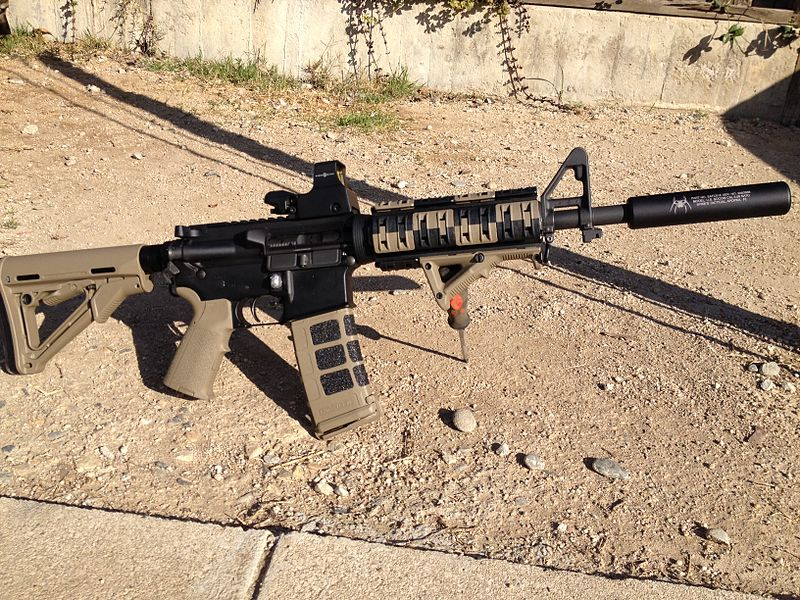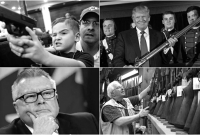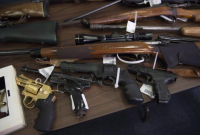It was the first mass shooting of 2018 in Canada.
In Toronto's Greektown, it left three people dead, including the shooter, who police said was 29-year-old Faisal Hussain.
The number of shootings in Toronto increased around 41 per cent between 2015 and 2016 and numbers rose sharply in 2017 as well. But Canada's rise in gun violence still pales in comparison with the U.S., where 189 mass shooting incidents have claimed 195 lives and wounded over 700 so far in 2018.
A school shooting on May 18 killed eight people, many of them students, at Santa Fe High School in Galveston County, south of Houston. A student was taken into custody amid the carnage. It's only the latest in a long string of violent school shootings across the U.S. In February, a mass school shooting on Valentine's Day left 17 high school students in Parkland, Florida, dead and 15 wounded. The total number of school shootings in the United States since the beginning of the year is 18 (or roughly three per week), according to the gun control advocacy group Everytown for Gun Safety. There have been zero school shootings in Canada during the same period.
"Americans make up about 4.4 percent of the global population but own 42 percent of the world’s guns. From 1966 to 2012, 31 percent of the gunmen in mass shootings worldwide were American, according to a 2015 study by Adam Lankford, a professor at the University of Alabama," The New York Times reports.

A review of 2015’s total for firearms-related deaths in the U.S. shows that the Gun Violence Archive (GVA) recorded 12,236 deaths and a further 24,755 injuries from shootings. This casualty toll includes 640 children aged 0-11 killed or injured by guns.
Not all these deaths were straight-up homicides. The GVA recorded 1,749 accidental shootings, 1,131 cases of ‘defensive use’, 4,028 incidents involving police, and 2,081 home invasions.
309 deaths were a result of mass shootings.
Canadian comparison
According to a StatsCan report from 2012 – the most recent year available – the U.S. suffered a total of 8,813 murders involving the use of firearms that year. Canada, in the same year, recorded just 172 firearms-related homicides. The guns often turn out to have come from America.

“When looking at firearm-related homicide rates in comparable countries, Canada’s rate is about seven times lower than that of the United States (3.5 per 100,000 population), although it is higher than several other peer countries. While Canada’s firearm-related homicide rate is similar to those in Ireland and Switzerland, it is significantly higher than the rates in Japan (0.01 per 100,000 population) and the United Kingdom (0.06 per 100,000 population),” states StatsCan’s findings, which do not include Quebec figures.
Presently, Canadian law classifies firearms into three categories: prohibited, restricted, and non-restricted. Prohibited firearms include military-grade assault weapons such as AK-47s and sawn-off rifles or shotguns. Handguns are generally classified as restricted weapons, while rifles and shotguns are usually non-restricted. The AR-15 rifles used by the San Bernardino suspects is classified as restricted.

Anyone wishing to buy a gun in Canada and/or ammunition must have a valid licence under the Firearms Act. To obtain a firearms licence, all applicants must undergo a screening process, which includes a safety course, criminal history and background checks, provision of personal references, and a mandatory waiting period.
But Canada’s relatively tight firearms laws were loosened when then PM-Stephen Harper scrapped the federal Long Gun Registry. While in existence from 1993 – 2012, the registry was a centralized RCMP database that linked all guns with their respective owners. The Conservatives scrapped the database as they saw it as ineffective at reducing crime, targeting law-abiding gun owners instead of criminals, who typically don't register their weapons. However, Canadian police and victims groups fought hard to keep it, partly because it helped authorities evaluate potential safety threats when police officers attended potential criminal incidents.
Current Conservative Party leader Andrew Scheer removed a page on his gun policies from his website after winning the party's leadership race, according to the Globe and Mail, but supports removing the power of the RCMP to “arbitrarily make reclassifications” of firearms, preferring to give that authority to "accountable" elected representatives.
But Canadians remain generally more in favour of strict gun laws, and are less inclined to adopt the loose gun laws of the U.S.

Law of the gun
Even with the Long Gun Registry’s destruction, Canadian firearms laws are still much tougher than those in the U.S., which allowed the San Bernardino shooters to access assault rifles usually reserved for trained soldiers.
Unlike any other industrialized country, the right to bear arms was declared a constitutionally-enshrined right in America, when the nation first came into being in the late 1700s. In modern times, the National Rifle Association (NRA) has poured millions of dollars into political campaigns, ensuring that gun laws remain lax.
As a result, there are now roughly 300 million firearms in the U.S. according to some estimates, nearly one per person in a country of 319 million people. By contrast, Canada had approximately seven million registered firearms at the end of 2011, in a country of roughly 35 million people. Even if Canada had the same population as the U.S., this number would still only work out to about 70 million weapons. The Small Arms Survey estimates that there are 270 million firearms in America, which still works out to 89 guns per 100 people, ranking America as the world's number one country for firearms ownership.
And buying a gun is much easier south of the border: background checks through the FBI database are only required for in-store purchases. Even then, it’s a relatively straightforward procedure of filling out an in-store form asking if the applicant has ever been convicted of a crime or committed to a mental institution, among other questions. The store then makes a quick call to the FBI and the whole process can be completed in minutes. Denials are rare, amounting to less than 1 per cent.
Anyone wishing to dodge even a cursory federal background check can simply buy weapons from gun shows, or from friends, family, and neighbours in private sales, according to CNN. The Democrats did try eliminating the gun show loophole in 2013, but the attempt failed to pass in a Republican-dominated Congress.
However, 18 states plus the District of Columbia have rolled out their own background checks, applicable to private sales and gun shows, to try and stop weapons from falling onto the wrong hands. These include California, Colorado, Connecticut, Delaware, New York, Oregon, Rhode Island, Washington State, Maryland, Pennsylvania, Hawaii, Illinois, Massachusetts, Iowa, Michigan, Nebraska, and North Carolina.
It was loopholes and lax checks that allowed racist gunman Dylan Roof to obtain the weapon that he then used to carry out a massacre of worshippers at an African-American church in Charleston, South Carolina. Despite being arrested for drug possession and trespassing – and had also displayed racist imagery on Facebook – he still met the legal requirements for buying a weapon.
Unlike the Deep South, where Roof claimed his victims, California has America’s strictest gun laws. This means that prospective gun owners must hold a Firearms Safety Certificate, submit to a waiting period like in Canada, buy weapons only through licensed dealers, and possess only a ‘California legal’ gun that complies with restrictions on what can and cannot be sold inside the state.
But these laws did not stop suspected San Bernardino shooters Tashfeen Malik and her husband Syed Rizwan Farook from allegedly obtaining AR-15 assault rifles, civilian variants of the M-16, standard infantry weapon of the U.S. military since Vietnam.

According to the New York Times, San Bernardino police said that the suspects’ guns included four ‘high-capacity’ magazines and more than 1,000 rounds of ammunition.
What does this mean for Canada’s gun laws?
In the immediate aftermath of the San Bernardino shootings, neither the Canadian government nor its federal opponents had much to say on America’s chronic problem with gun crime. Nor is there yet any indication of how this most recent shooting south of the border may impact firearm laws in Canada.
“Our thoughts and prayers are with the people of San Bernardino tonight as they come to grips with today’s terrible tragedy,” said Prime Minister Justin Trudeau in a tweet on Dec. 2.
However, the Liberals did promise during the election to tighten up gun laws that were eased under former Prime Minister Stephen Harper. The proposed measures include enhanced background checks for anyone seeking to buy a handgun or other restricted firearms and toughen up border security to prevent the illegal import of weapons from the U.S.
The Trudeau Liberals have also promised to repeal changes made by Conservative-era Bill C-42 that they say allows restricted and prohibited weapons to be freely transported without a permit.
But the Liberals’ promises stopped short of re-introducing the Long Gun Registry scrapped by Harper just over three years ago.
In Canada, at the federal level, according to the RCMP's website, firearms are regulated primarily by the Firearms Act and by Part III of the Criminal Code. The Firearms Act and its supporting regulations set out the rules for possessing a firearm. The Criminal Code and its supporting regulations identify the various firearms, weapons and devices regulated by the Firearms Act.
Provinces, territories or municipalities may have additional laws and regulations that apply in their jurisdiction. For example, provinces are responsible for regulating hunting. They may put restrictions on where hunting can take place and on the caliber or gauge of firearms that may be used for hunting particular game, the RCMP says.
At the federal level, The Firearms Act, an act respecting guns was passed in Canada in 1995. Read more about the act here.
Editor's Note: This story is periodically updated by National Observer staff.
With files from Fram Dinshaw and Edward Ngai






Comments
The AR-15 is not a military "automatic rifle". It's a semi-automatic rifle firing the .223 cartridge, which is close to being the least powerful center-fire rifle cartridge available. Any semi-automatic rifle, like the Ruger Mini 14, which also chambers it, can fire at exactly the same rate and with comparable accuracy. Firearms like the AR-15 end up on "restricted" lists because they have features like flash suppressors, pistol grips, and collapsible stocks, features that have absolutely no effect on the actual operation of the weapon.
The AR (Armalite) platform is one of the most popular rifle platforms in the US, simply because it's light, easy to shoot, even for women, and ammunition is cheaper than more powerful rounds like the .308 (which tend to have more recoil as well). When you have a popular rifle then it is more likely to be used in shootings, although most criminal shootings are still with handguns.
The San Bernardino shooters, and the Orlando shooter, used the AR-15, not the military's automatic M-16 or M-4 carbine. They used them because they're common and reliable, not because they offer any superiority in firepower over another .223 semi-automatic rifle.
America does have a problem with criminal violence with firearms, that is true. However attempting to demonize a particular style of firearm just because of how it looks is just plain stupid.
You wrote that long of a diatribe to correct the use of the phrase "assault riffle"... Good attempt to deflect from the real problem being discussed.
The entire article is distracting from the real issue in America. They aren't murdering each other simply because there are guns around they have very deep social problems that need to be addressed. Anyone who thinks it's difficult to get a gun in Canada simply doesn't know what they are talking about. I just bought one private sale yesterday and it's simply a cash for goods transaction. The ownus is on the buyer to be licenced not the seller to check. Also the gun numbers for Canada came from a registry that many chose not to take part in. Looking at import and manufacturing data it shows we are the second most armed country yet we aren't all offing each other. Stop blaming the tool it's people.
It's certainly true that US gun violence is a product of social and even economic issues as much as the raw number of guns. For that matter, even when it comes to laws, it's not just about getting access to them in the first place--Canada has stronger storage and transport laws, which makes a difference.
But yes, the masses of guns are more a symptom than a cause. The US is an empire which glorifies violence, a highly unequal society controlled by commercial and financial interests and leaving a lot of people living precarious lives. Since the US is an empire which uses a lot of violence, and that violence costs money, a lot of those commercial interests running things are in the violence trade, and the domestic population is just one more market. They encourage violence and fear, and all the US elites encourage social conflict to distract attention from themselves. So it all feeds off itself.
(Mind you, a lot of the shootings are done by people who are pretty well off . . . but I get the impression that even the wealthy are affected by it; even if factually they are prosperous and secure, they absorb the atmosphere of dog-eat-dog insecurity and fear. It's like the way many American politicians have come to believe their own propaganda)
That said, violent people WITHOUT guns can't kill as many victims as violent people WITH guns. Gun control is not irrelevant, just as treating disease symptoms is not useless. If someone has cholera and the dehydration from their diarrhea is killing them, then yes, you want to cure the cholera, but in the mean time rehydrating them is a good idea.
If you are interested in makeing your own free energy check out this link http://bit.ly/fr33energy
This crazy 56 year-old geography teacher in Memphis, Tennessee
believed he can change the energy world... and somehow he did it.
Check it out at:
https://goo.gl/x9s6Nb